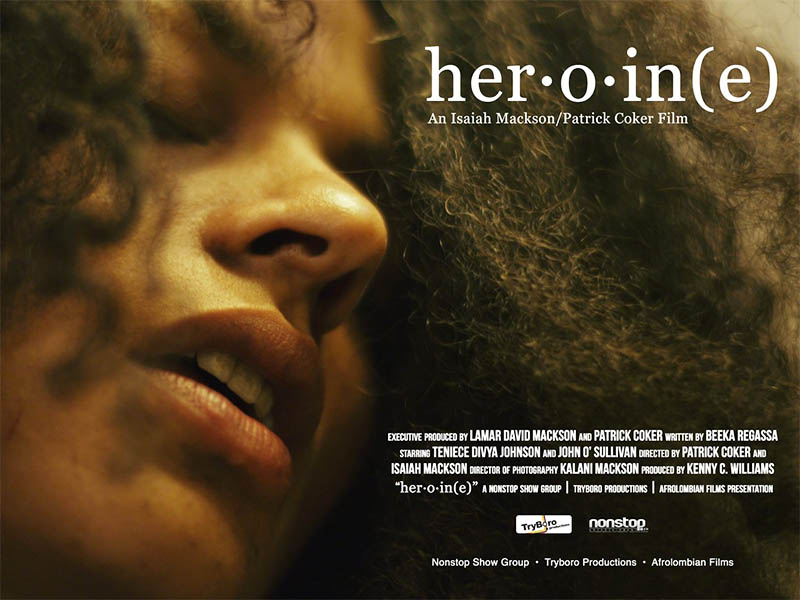
Through an artistic combination of image and sound, the creators of the poignant short film Heroin€ explore the intersection of some of the major crises of our time – the opioid epidemic and active shooters. JARO had the chance to speak with Mr. Lamar Mackson, executive producer and founder of Nonstop Show Group, to talk about the inspiration and logistics of filming and learned that the development was a real family affair. With eldest son Kalani serving as Director of Photography and his youngest son, Isaiah, as director, Heroin(e) is evidence of the dynamic, creative chemistry between the two brothers. Their father says, “The two were like yin and yang. They were mentally and creatively bonding with one another…There was almost a telepathy going on between the two of them. They were certainly in a zone. I’ve been working in production for 25 years and never seen anything like it before.”
The partnership between co-director Patrick Cocker (BET’s Tales) and actress Teniece Divya Johnson seems to fuel the emotional depth of the narrative. The movie follows Sylvia (Johnson), a heroin addict, as she goes about what seems like her typical day, scoring drugs, shooting up at a New Jersey PATH train station, and walking around in a general haze, hair almost completely covering her face. Johnson’s portrayal of Sylvia was so dynamic that it was one of the most challenging aspects of filming for Lamar Mackson. Johnson, typically a “bubbly, charismatic person, was in character 24/7 for the three-day shoot. She would nod in and out.” Mackson says that Johnson went so deep into character that several commuters at the station and on the train looked at her as though “she was really getting high.” Born out of logistical feasibility, the train station soon became a powerful site and symbol for the film.
The original script, which Isaiah discovered in the student script bank at his film school, was set at a mall. By relocating the narrative to the train station, the creators were able to invoke both the metaphor of tracks – the train and the addict’s arm – and the station as a site of “entrance and egress.”
The visual and auditory presence of the train station, as well as the creative sound design, ties together scenes and the seemingly fractured memory of Sylvia, who has an addiction and makes for a dynamic way of amplifying the use of audio to weave a story with little dialogue. Another Mackson family member forged the sound – Zuberi “ Young Audio” Mackson, whose master mix sets the tone for the short.
The intentionality in costume offers an enlightening moment when Sylvia, whose face is typically covered by her hair, is in full view when she is greeted and acknowledged by a little boy outside the church. The unveiling of Sylvia’s face is a pivotal moment during the film, representing a look at the anonymous citizen often overlooked in our society.
Mackson explains what seems to be a troubling pattern in our current society that he addresses in the film: “We overlook people because you are not suffering from what they are suffering from. What is going on today is a result of us doing that – overlooking people’s suffering.” This work is an inversion. Essentially, this woman who is disposable because of her addiction is the one who ends up saving the lives of the very woman who denied her dignity. Mackson hopes that Heroin(e) will help others better understand how “we often overlook and misinterpret the heroine, who could be that overlooked individual on the street…they have potential to save others.” In a beautiful way, this project challenges our lives off the screen and encourages us to reconsider our relationships and values. In a time where we are so quick to dispose of one another, Heroin(e) forces us to stop and rethink how we value and evaluate who deserves to be seen and treated with respect, who is, in fact, human.
For more information regarding Heroin(e) or to keep up with the Mackson family’s latest project, please follow them on Facebook and Instagram at @nonstopshowgroup, @heroinefilm or visit www.nonstopshowgroup.com You can also get updates on their upcoming psychological thrillers White Pickett Fence directed by Jacqueline Howell King, Mourning Meal directed by Jamal Hodge as well as the action comedy TV pilot, Too Many Heroes directed by Patrick Coker and the Episode 7 of the breakout comedy No Sleep til Forty directed by John Pellum.
. I’ve been working in a production for 25 years and never seen anything like it before.”
Their partnership along with that of co-director Patrick Cocker (BET’s Tales) and actress Teniece Divya Johnson, seems to be what fuels the emotional depth of the narrative. The movie follows Sylvia (Johnson), a heroin addict, as she goes about what seems like her typical day, scoring drugs, shooting up at a New Jersey PATH train station, and walking around in a general haze, hair almost completely covering her face. Johnson’s portrayal of the Sylvia was so dynamic that for Lamar Mackson, it was one of the most difficult aspects of filming. Johnson who is typically a “bubbly, charismatic person, was in character 24/7 for the three-day shoot. She would just nod in and out.” Mackson says that Johnson went so deep into character that several commuters at the station and on the train, looked at her as though “she was really getting high.” Born out of logistical feasibility, the train station soon became a powerful site and symbol for the film.
The original script, which Isaiah discovered in the student script bank at his film school, was set at a mall. By relocating the narrative to the train station, the creators were able to invoke both the metaphor of tracks – the train, as well as the addict’s arm – as well as the station as a site of “entrance and egress.”
The visual and auditory presence of the train station, as well as the creative sound design, ties together scenes and the seemingly fractured memory of Sylvia, the addict, and makes for a dynamic way of amplifying the use of audio to weave a story with little dialogue. The sound was forged by another Mackson family member – Zuberi “ Young Audio” Mackson, whose master mix sets the tone for the short.
The intentionality in costume offers an enlightening moment when Sylvia, whose face is typically covered by her hair is in full view, when she is greeted and acknowledged by a little boy outside of the church. The unveiling of Sylvia’s face is a pivotal moment during the film representing look at the anonymous citizen often overlooked in our society.
Mackson explains what seems to be a troubling pattern in our current society that he addresses in the film: “We overlook people because you are not suffering from what they are suffering from. What is going on today is a result of us doing that – overlooking people’s suffering.” This work is an inversion. Essentially this woman who is disposable because of her addiction is the one who ends up saving the lives of the very woman who denied her, her dignity. Mackson hopes that Heroin(e) will help others to have a better understanding of how “we often overlook and misinterpret the heroine, who could be that overlooked individual on the street…they have potential to save others.” That is the beauty of the project is that it challenges our lives off the screen and encourages us to reconsider our relationships and our values. In a time where we are so quick to dispose of one another, Heroin(e) forces us to stop and reconsider how we value and evaluate who deserves to be seen and treated with a respect, who is in fact, human.
For more information regarding Heroin(e) or to keep up with the Mackson family’s latest project please follow them on Facebook and Instagram at @nonstopshowgroup, @heroinefilm or visit www.nonstopshowgroup.com You can also get updates on their upcoming psychological thrillers White Pickett Fence directed by Jacqueline Howell King, Mourning Meal directed by Jamal Hodge as well as the action comedy TV pilot, Too Many Heroes directed by Patrick Coker and the Episode 7 of the breakout comedy No Sleep til Forty directed by John Pellum.






